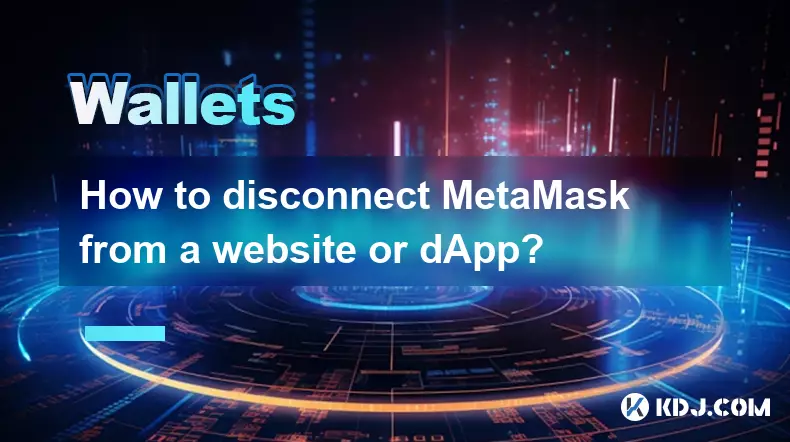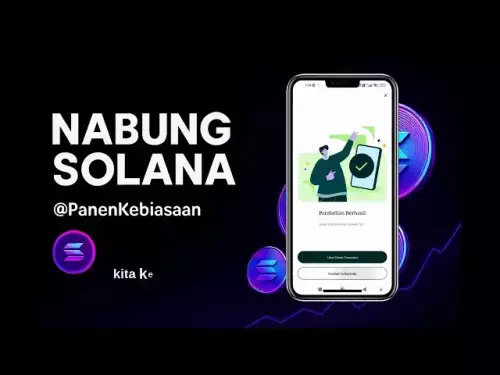-
 bitcoin
bitcoin $115849.501581 USD
-0.20% -
 ethereum
ethereum $4657.446044 USD
-1.30% -
 xrp
xrp $3.094289 USD
-0.74% -
 tether
tether $1.000313 USD
-0.03% -
 solana
solana $243.548889 USD
0.20% -
 bnb
bnb $930.722647 USD
0.20% -
 usd-coin
usd-coin $0.999696 USD
-0.01% -
 dogecoin
dogecoin $0.283551 USD
1.29% -
 tron
tron $0.349632 USD
-0.77% -
 cardano
cardano $0.915982 USD
-1.94% -
 hyperliquid
hyperliquid $54.899464 USD
-0.88% -
 chainlink
chainlink $24.718086 USD
-1.68% -
 ethena-usde
ethena-usde $1.001078 USD
-0.02% -
 sui
sui $3.756062 USD
0.14% -
 stellar
stellar $0.399024 USD
-1.87%
How to disconnect MetaMask from a website or dApp?
MetaMask stays connected to dApps until manually disconnected, so always revoke access after use to prevent unauthorized requests and enhance security.
Sep 12, 2025 at 12:54 am

Understanding MetaMask Connection to dApps
1. When users interact with decentralized applications, MetaMask establishes a connection to verify identity and enable blockchain transactions. This link allows the dApp to request transaction approvals and access basic wallet details such as the public address. While convenient, persistent connections can expose users to potential risks if the dApp is no longer in use or appears suspicious.
2. The connection does not automatically expire after a session ends. Even after closing the browser, the dApp may retain access until manually disconnected. This behavior stems from how Ethereum-based applications handle session persistence through browser storage and wallet permissions.
3. Disconnecting is essential for maintaining control over which platforms can interact with your wallet. It prevents unauthorized transaction requests and limits data exposure. Many users overlook this step, assuming navigation away from the site terminates access, which is not the case.
4. MetaMask itself does not provide a centralized dashboard to view or manage connected sites. Instead, disconnection must be initiated either through the dApp's interface or by clearing site data directly from the browser. This decentralized approach places responsibility on the user to maintain security.
5. Some dApps display a 'Disconnect Wallet' button prominently, while others hide it within settings or user menus. Users must actively look for this option after finishing their session to ensure the link is severed.
Steps to Manually Disconnect from a dApp
1. Navigate to the dApp’s interface and locate the wallet connection indicator, usually found in the top-right corner. Clicking on it often reveals options related to the active wallet session.
2. Look for a button labeled 'Disconnect,' 'Disconnect Wallet,' or similar wording. Clicking this will terminate the current session and revoke the dApp’s ability to request transactions or read wallet data.
3. If no disconnect option is visible, check the settings or profile section of the dApp. Some platforms place the function under privacy or security menus rather than the main interface.
4. After disconnecting, refresh the page to confirm that the wallet is no longer linked. The dApp should prompt you to reconnect if further interaction is needed.
5. For added security, clear the browser's cache and site data for the specific domain. This removes any stored permissions or session tokens that might persist even after disconnection.
Managing Permissions via Browser Settings
1. Open your browser’s settings and navigate to the privacy or site permissions section. Here, you can view which websites have access to specific features, including Ethereum or cryptocurrency-related APIs.
2. Search for the dApp’s domain in the list of sites with permissions. If found, select it and choose to remove or reset permissions. This action effectively cuts off communication between MetaMask and the site.
3. In Google Chrome, go to Settings > Privacy and security > Site Settings > Additional content settings > Ethereum. Review the list and remove any unwanted entries.
4. For Firefox users, access about:preferences#privacy, scroll to Permissions, and click Settings next to 'Notifications' or 'Camera' to find Ethereum-related permissions if available through extensions.
5. Always verify that the site no longer appears in the connected list after removal. Revisiting the dApp should require a fresh connection approval.
Security Implications of Connected dApps
1. A connected dApp can initiate transaction requests without prior warning, relying on MetaMask’s confirmation prompt. Malicious actors exploiting compromised dApps may attempt to trick users into signing harmful transactions.
2. Even benign dApps may collect behavioral data linked to your wallet address, building a profile of your on-chain activity. Disconnecting limits long-term tracking and enhances privacy.
3. Regularly auditing connected sites reduces the attack surface. Treat wallet connections like app permissions on a mobile device—only grant access when necessary and revoke when done.
4. Phishing sites mimicking legitimate dApps can trick users into connecting wallets. Once connected, these sites may display fake transaction requests. Immediate disconnection minimizes potential damage.
5. There is no universal timeout for dApp connections. A wallet linked months ago remains vulnerable if the site is compromised later. Proactive disconnection is a critical hygiene practice.
Frequently Asked Questions
Can a dApp steal funds just by being connected? No, a connected dApp cannot withdraw funds without explicit user approval for each transaction. However, it can request transactions that, if approved unknowingly, may lead to loss of assets.
Does clearing browser cookies disconnect MetaMask automatically? Yes, clearing cookies and site data for the dApp’s domain typically removes connection permissions, requiring re-authorization upon next visit.
Is there a way to see all sites currently connected to MetaMask? MetaMask does not offer a built-in list of connected sites. Users must rely on browser settings or memory of visited dApps to track connections.
What happens if I reconnect to a dApp after disconnecting? Reconnecting re-establishes the permission, allowing the dApp to interact with your wallet again. The process mirrors the initial connection, requiring address confirmation.
Disclaimer:info@kdj.com
The information provided is not trading advice. kdj.com does not assume any responsibility for any investments made based on the information provided in this article. Cryptocurrencies are highly volatile and it is highly recommended that you invest with caution after thorough research!
If you believe that the content used on this website infringes your copyright, please contact us immediately (info@kdj.com) and we will delete it promptly.
- Bitcoin Price Watch: Is USD 116,000 the New Normal?
- 2025-09-14 14:25:16
- Cardano, BNB, and Analyst Targets: Decoding the Crypto Forecast
- 2025-09-14 14:25:16
- Karddun Token: Redefining E-commerce with Cryptocurrency Payments
- 2025-09-14 14:30:01
- Kardvin Token (KRN): Bullish Predictions Driven by Low Transaction Costs?
- 2025-09-14 14:30:01
- MAGACOIN FINANCE Presale: The Top Crypto Opportunity of 2025?
- 2025-09-14 14:30:01
- DAO Projects & Social Buzz: Who's Leading the Charge?
- 2025-09-14 12:25:15
Related knowledge

How to check your crypto portfolio performance in Exodus?
Sep 14,2025 at 08:36am
Accessing Your Portfolio Overview in Exodus1. Launch the Exodus application on your desktop or mobile device and enter your password to unlock your wa...

How to sell crypto from your Exodus wallet?
Sep 13,2025 at 12:01pm
Selling Crypto from Your Exodus WalletExodus is a popular non-custodial wallet that supports a wide range of cryptocurrencies. While it doesn’t allow ...

How to back up your Exodus wallet?
Sep 11,2025 at 04:19pm
Understanding Exodus Wallet Backup Basics1. Exodus is a software wallet that allows users to store, manage, and exchange various cryptocurrencies dire...

How to transfer funds from Binance to your Exodus wallet?
Sep 10,2025 at 10:19pm
Connecting Your Binance Account to Exodus Wallet1. Log in to your Binance account and navigate to the 'Wallet' section under the 'Funds' tab. Select '...

What cryptocurrencies does the Exodus wallet support?
Sep 11,2025 at 03:36pm
Overview of the Exodus WalletExodus is a user-friendly cryptocurrency wallet that supports a wide range of digital assets. Designed for both beginners...

How to export your Exodus transaction history for taxes?
Sep 12,2025 at 04:36pm
Exporting Transaction History from Exodus for Tax Reporting1. Open the Exodus wallet application on your desktop and ensure all transactions are synce...

How to check your crypto portfolio performance in Exodus?
Sep 14,2025 at 08:36am
Accessing Your Portfolio Overview in Exodus1. Launch the Exodus application on your desktop or mobile device and enter your password to unlock your wa...

How to sell crypto from your Exodus wallet?
Sep 13,2025 at 12:01pm
Selling Crypto from Your Exodus WalletExodus is a popular non-custodial wallet that supports a wide range of cryptocurrencies. While it doesn’t allow ...

How to back up your Exodus wallet?
Sep 11,2025 at 04:19pm
Understanding Exodus Wallet Backup Basics1. Exodus is a software wallet that allows users to store, manage, and exchange various cryptocurrencies dire...

How to transfer funds from Binance to your Exodus wallet?
Sep 10,2025 at 10:19pm
Connecting Your Binance Account to Exodus Wallet1. Log in to your Binance account and navigate to the 'Wallet' section under the 'Funds' tab. Select '...

What cryptocurrencies does the Exodus wallet support?
Sep 11,2025 at 03:36pm
Overview of the Exodus WalletExodus is a user-friendly cryptocurrency wallet that supports a wide range of digital assets. Designed for both beginners...

How to export your Exodus transaction history for taxes?
Sep 12,2025 at 04:36pm
Exporting Transaction History from Exodus for Tax Reporting1. Open the Exodus wallet application on your desktop and ensure all transactions are synce...
See all articles










































































